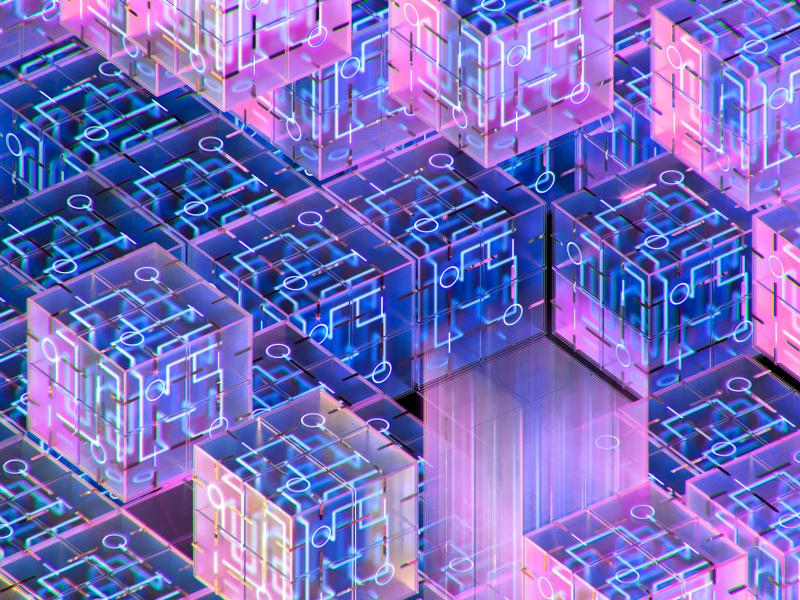Nov 17 2020
Dependable qubit-based calculating devices will not stand alone when they arrive on the computing scene. But to reach their fullest potential, these devices must cooperate with existing scientific computing resources.
 Connecting multiple graphical processing units (GPUs) amplifies their computing power. Image Credit: Jeffrey London|Pacific Northwest National Laboratory.
Connecting multiple graphical processing units (GPUs) amplifies their computing power. Image Credit: Jeffrey London|Pacific Northwest National Laboratory.
Computer scientists from the Pacific Northwest National Laboratory (PNNL), along with the team from Microsoft Quantum, have taken a crucial step in that direction.
The scientists worked collaboratively and ultimately linked a quantum circuit density-matrix simulator (DM-SIM), which was developed by PNNL, to the Microsoft Q# quantum programming ecosystem. The DM-SIM runs on a supercomputer at the U.S. Department of Energy (DOE).
Such a “bridging” capability represents a stepping-stone, enabling computer program developers to produce and test algorithms so that quantum computers can be operated, even when they are still prototypes.
Sriram Krishnamoorthy, a computer scientist from PNNL, presented the outcomes of the first complete demonstration run at an event sponsored by Microsoft at the time of the annual Supercomputing Conference (SC20).
Krishnamoorthy and Ang Li, another computer scientist from PNNL, revealed the DM-Sim quantum circuit simulator, which was nominated for “Best Paper” at SC20.
We are building toward a robust development pipeline connecting our novel DM-Sim quantum circuit simulator to DOE computing resources. This demonstration shows that we can successfully run a complete simulation that combines an independently built quantum simulation tool with Microsoft’s open-source programming ecosystem.
Sriram Krishnamoorthy, Computer Scientist, Pacific Northwest National Laboratory
Creating a Communication Portal
These kinds of communication bridges are necessary yet common in the computer field. Whenever individuals send a text message or access a social network, they are utilizing one of these communication bridges, known as application programming interfaces, or APIs for short.
API bridges are similar to simultaneous translators and enable computers to speak different kinds of languages and still comprehend one another.
In this example, the API developed at Microsoft links the quantum computing simulation code of PNNL to Microsoft Quantum’s Q# programming language as well as to its “quantum intermediate representation” (QIR) through a “wrapper” developed by PNNL.
Along with the bridge API and QIR, the wrapper enables the Q# programming language to run on the significant computing muscle available at the Summit supercomputer based at the Oak Ridge National Laboratory.
It can be described as a kind of mega API—one that allows concurrent development and testing of both the software and quantum devices that will someday run on these kinds of devices. According to the researchers, it is a crucial bridge to full-scale quantum computing.
We are aiming toward a tool chain to solve computationally challenging chemistry problems,” said Li. “These problems require a co-development solution that gives our developers a chance to iteratively test and refine the algorithms that will operate quantum computers.
Ang Li, Computer Scientist, Pacific Northwest National Laboratory
DM-SIM Quantum Circuit Simulator
While excitement builds around the potential of quantum computing, traditional supercomputers continue to rule scientific computing. Even today, the reliability and speed of these supercomputers cannot be matched by any quantum computing device.
Moreover, quantum computers are prone to errors. It is believed that the DM-Sim quantum circuit simulator will shed light on the nature of these errors, enabling scientists to replicate quantum circuits with the help of a traditional computer.
As the researchers learn more about ways to make quantum bits—known as qubits—more stable, they will analyze the nature of these errors and the means to withstand their presence within the scope of quantum calculations.
The study also supports the DOE-supported Quantum Science Center—a relatively larger effort that is aiming to jointly design quantum algorithms and simulation.
Apart from Li and Krishnamoorthy, Bo Feng, a computer programmer from PNNL, helped design the “wrapper” that links the DM-Sim quantum circuit simulator to the Microsoft API.
Alan Geller, Bettina Heim, Irina Yatsenko, Guenevere Prawiroatmodjo, and Martin Roetteler, all collaborators from Microsoft Quantum, worked together to design the API at Microsoft Quantum and link it to the PNNL-developed quantum simulator.
The PNNL researchers were supported by the Quantum Science, Advanced Accelerator (QUASAR) laboratory-directed research and development initiative.